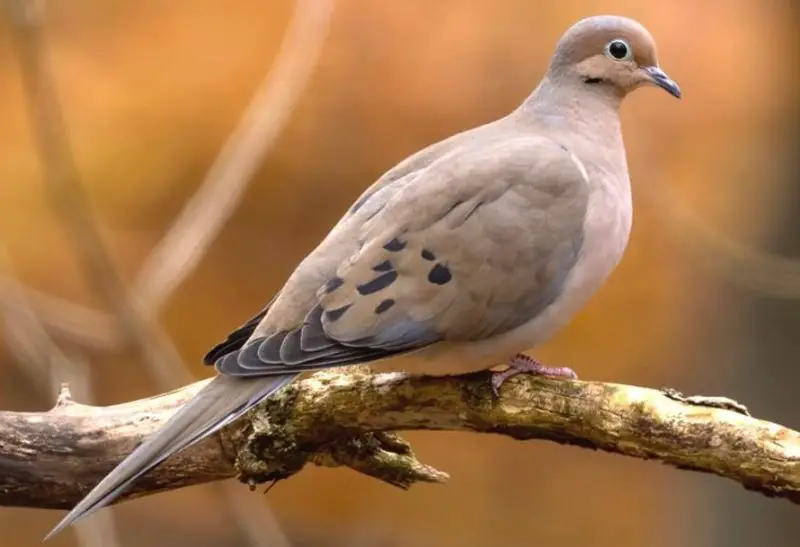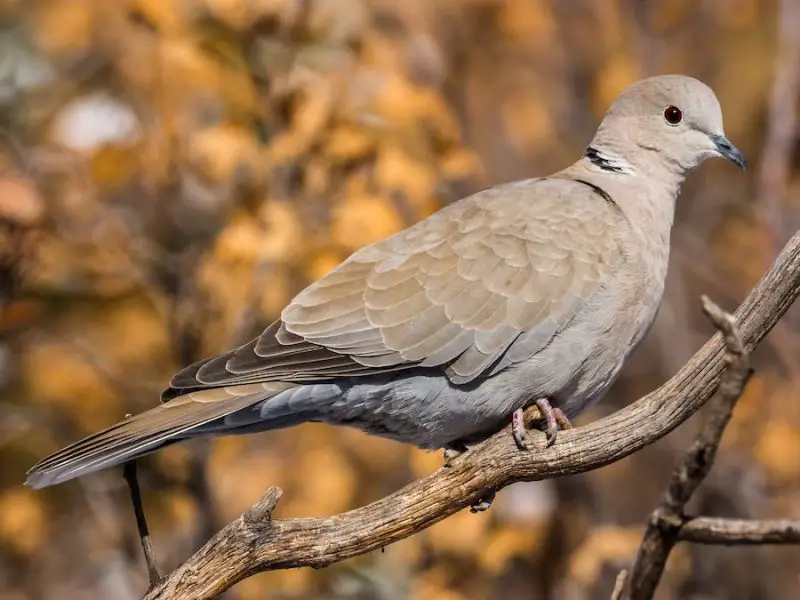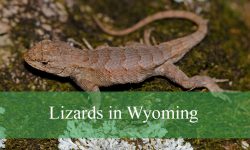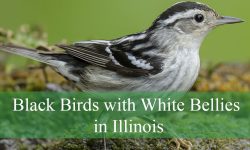Indiana’s diverse landscapes, ranging from sprawling farmland and dense woodlands to bustling urban areas, create an ideal environment for a variety of bird species. Among these, doves stand out for their elegance, subtle beauty, and characteristic calls. Known for their soft cooing sounds and graceful flight, doves are often spotted perched on telephone wires, rooftops, or quietly foraging on the ground.
Understanding the differences between the species can enhance birdwatching experiences, especially for those seeking to identify them accurately. This article explores three prominent dove species in Indiana: the Mourning Dove, the Eurasian Collared-Dove, and the White-winged Dove.
For each species, we will examine their physical traits, behavior, feeding habits, habitats, and unique characteristics to provide a comprehensive guide for bird enthusiasts.
Mourning Dove (Zenaida macroura)

The Mourning Dove is one of the most common and recognizable birds in Indiana. Measuring about 12 to 13 inches in length with a wingspan of approximately 17 to 18 inches, this medium-sized bird exhibits a slender body and a long, pointed tail. Its plumage is soft grayish-brown with subtle pink undertones on the chest and underparts. Black spots scattered across the wings and a bluish-gray ring around the dark eyes add to its distinctive appearance. The Mourning Dove’s delicate form and understated coloring allow it to blend seamlessly into open fields and forest edges, making it a subtle yet captivating presence in Indiana’s natural scenery.
Behaviorally, Mourning Doves are known for their characteristic soft, mournful cooing calls, which give the species its name. Their call, a gentle “coo-COO-coo,” is often heard during the breeding season, echoing across open landscapes. Typically solitary or found in pairs, they exhibit calm and deliberate movements, punctuated by bursts of quick flight. When startled, their flight is marked by rapid wingbeats followed by brief glides, often accompanied by a soft whistling sound produced by their wings. This flight pattern, along with their graceful posture, makes them easily identifiable even at a distance.
Mourning Doves inhabit a wide variety of environments in Indiana. They are frequently observed in open habitats such as farmlands, grasslands, and forest edges, but they are equally at home in urban and suburban areas. Perching on telephone wires or building ledges is a common sight, and they are remarkably adaptable to human presence. Northern populations of Mourning Doves migrate south during the winter, while southern populations may remain in place year-round, reflecting the species’ adaptability to seasonal changes.
Feeding habits of Mourning Doves revolve primarily around seeds. They forage mainly on the ground, consuming seeds from grasses, weeds, and cultivated crops, often accompanied by small amounts of grit to aid digestion. Their feeding behavior is diurnal, with peak activity occurring in the early morning and late afternoon. Despite their delicate appearance, Mourning Doves can consume up to 20 percent of their body weight in a single feeding session, an essential adaptation during migration or times of scarce food availability.
A fun and lesser-known fact about Mourning Doves is their ability to produce two broods of chicks in a single breeding season, a trait that supports population stability. Their chicks, known as squabs, grow quickly, and the adults demonstrate remarkable dedication in feeding and protecting their young, making them a fascinating species to observe for birdwatchers of all levels.
Eurasian Collared-Dove (Streptopelia decaocto)

The Eurasian Collared-Dove is slightly larger than the Mourning Dove, measuring approximately 13 to 14 inches in length with a wingspan of around 24 inches. Its soft grayish plumage is highlighted by a striking black crescent-shaped “collar” on the back of the neck, which lends the species its name. The tail is long and squared-off, contrasting with the rounded bodies of other doves, and the legs are vivid red. A black bill and dark eyes with a red iris complete its distinctive appearance. This dove’s subtle yet elegant coloring, combined with the iconic collar, makes it relatively easy to identify in the wild.
The Eurasian Collared-Dove is known for its soft cooing calls, usually described as a three-part “coo-COO-coo,” similar to the Mourning Dove but with slight tonal differences. Unlike the migratory Mourning Dove, Eurasian Collared-Doves are largely non-migratory, residing in Indiana year-round. They are social birds, frequently seen in pairs or small groups, and display calm and methodical flight patterns. Their adaptability to urban environments, coupled with a gentle and approachable demeanor, allows them to thrive in both rural farmlands and densely populated suburban areas.
Originally native to Southeast Asia, the Eurasian Collared-Dove has expanded its range rapidly across North America over the past several decades. In Indiana, this species is now widely distributed, often nesting on rooftops, ledges, and utility poles, which has facilitated their successful colonization of urban and suburban regions. Their adaptability to human-altered landscapes is a key factor in their remarkable expansion and continued prevalence in the state.
Feeding primarily on seeds, grains, and small fruits, Eurasian Collared-Doves often forage on the ground or visit bird feeders in residential areas. They are diurnal foragers, typically active during morning and late afternoon hours. This species demonstrates remarkable resilience, capable of thriving in diverse environments, from open farmlands to city parks. A fascinating behavioral trait of this species is its tendency to form long-term pair bonds, often staying with the same mate for multiple breeding seasons.
A fun fact about Eurasian Collared-Doves is their extraordinary adaptability. Since their introduction to North America, they have spread at an unprecedented rate, showcasing the species’ ability to thrive in new environments. Birdwatchers often notice their calm demeanor, social nature, and characteristic cooing sounds, making them a delightful species to observe throughout the year.
White-winged Dove (Zenaida asiatica)

The White-winged Dove is larger than both the Mourning Dove and the Eurasian Collared-Dove, measuring approximately 13 to 14 inches in length with a wingspan of 24 inches. Its plumage is mostly grayish-brown, but the species is easily distinguished by the striking white patches on its wings, visible in flight. A long, pointed tail and red legs further enhance its distinctive appearance, while the bright orange eyes and blue skin around the eyes add a vivid splash of color. This dove’s unique wing pattern and bold facial features make it one of the most visually striking species in Indiana.
White-winged Doves are known for their deep, resonant cooing, often vocalized as a three-note sequence reminiscent of “who-cooks-for-you.” Social in nature, they are typically observed in pairs or small flocks. These doves are monogamous, often forming long-term pair bonds, and they demonstrate strong parental care toward their chicks. Their flight is graceful yet powerful, characterized by smooth, steady wingbeats.
Although native to the southwestern United States, the White-winged Dove has expanded its range into Indiana, where it is increasingly observed in urban and suburban areas. These doves are highly adaptable to human-altered habitats, thriving wherever food sources and nesting opportunities exist. They are often found foraging in parks, backyards, and open fields, demonstrating a remarkable ability to integrate into both natural and urban ecosystems.
The diet of White-winged Doves consists mainly of seeds, grains, and fruits. They are especially known for feeding on the seeds and pulp of cacti in their native range, but in Indiana, they adapt to local food sources, often feeding on cultivated grains and visiting bird feeders. Their feeding activity is concentrated during daylight hours, with early morning and late afternoon as peak times.
An interesting fact about White-winged Doves is that their striking white wing patches are not only visually distinctive but also serve as an important signaling mechanism during flight, allowing them to maintain cohesion in flocks and communicate during migration. Their bright orange eyes and striking wing patterns make them highly noticeable, and birdwatchers often find them a favorite species due to their beauty and elegance.
Best Time and Places to Observe Doves in Indiana
Observing doves in Indiana can be a rewarding experience, especially when you know the optimal times and locations for spotting them. Each species has slightly different patterns in terms of activity, habitat preference, and seasonal presence, which can help birdwatchers maximize their chances of seeing them in the wild.
Mourning Dove
The Mourning Dove is widespread throughout Indiana and can be observed year-round, though their numbers increase in certain areas during migration periods. Early morning and late afternoon are the most active times, as these birds forage for seeds on open fields and grasslands. Ideal locations include agricultural areas, open meadows, and forest edges. Urban parks and suburban yards are also excellent spots, as Mourning Doves frequently perch on rooftops, telephone wires, and fences. Spring and summer are particularly rewarding times to observe them, as pairs are actively building nests and feeding young, offering plenty of natural behavior to watch.
Eurasian Collared-Dove
Eurasian Collared-Doves are non-migratory and can be seen throughout the year in Indiana. They are highly adaptable to human environments, making suburban neighborhoods, small towns, and city parks prime observation spots. Like Mourning Doves, they are most active during early morning and late afternoon when they search for seeds and grains on the ground or visit feeders. They often gather in small flocks, especially near food sources, so residential areas with bird feeders can provide excellent opportunities for observation. Rooflines, utility poles, and trees near open spaces are the best vantage points to watch their characteristic cooing calls and flight patterns.
White-winged Dove
White-winged Doves are less common in Indiana than the other two species, but they have been expanding their range northward. They are most likely to be seen during late summer and early fall, coinciding with post-breeding dispersal when young birds move into new areas. Urban parks, suburban neighborhoods, and open fields with abundant seed sources are ideal for spotting them. Observing them during early morning and late afternoon provides the best chances, as they are most actively feeding during these times. Watching for the distinctive white wing patches in flight helps distinguish them from other doves and adds a striking visual element to birdwatching sessions.
Conclusion
Indiana’s diverse environments support a rich variety of dove species, each exhibiting unique characteristics and behaviors. The Mourning Dove, Eurasian Collared-Dove, and White-winged Dove demonstrate remarkable adaptability, whether foraging in urban areas, nesting on rooftops, or migrating across the landscape. By learning to identify these species based on their physical traits, calls, behavior, and habitats, birdwatchers can gain a deeper appreciation for the state’s avian diversity. Observing these doves in their natural environment not only enhances the birdwatching experience but also fosters an understanding of how human-altered landscapes influence the distribution and success of these graceful birds.
For more comprehensive information on Indiana’s bird species, resources such as the Indiana Audubon Society and the Cornell Lab of Ornithology provide detailed guides, identification tips, and conservation efforts. Engaging with these resources can enrich one’s knowledge of the state’s birds and support efforts to protect and conserve their natural habitats. Whether exploring rural fields, suburban parks, or urban neighborhoods, observing Indiana’s doves offers an enriching experience for both novice and seasoned bird enthusiasts alike.
FAQs About Doves in Indiana
What types of doves are commonly found in Indiana?
The most common doves in Indiana are the Mourning Dove (Zenaida macroura), the Eurasian Collared-Dove (Streptopelia decaocto), and the White-winged Dove (Zenaida asiatica). Mourning Doves are widespread across the state, Eurasian Collared-Doves are increasingly common in suburban areas, and White-winged Doves are occasionally spotted as their range expands northward.
How can I identify a Mourning Dove?
Mourning Doves are medium-sized, slender birds with grayish-brown plumage and black spots on their wings. They have a long, pointed tail and a bluish-gray ring around dark eyes. Their soft, mournful “coo-COO-coo” call is a key identifier, and they often perch on telephone wires or forage on the ground for seeds.
What distinguishes a Eurasian Collared-Dove from other doves?
The Eurasian Collared-Dove is slightly larger than a Mourning Dove, with pale gray plumage and a distinctive black crescent-shaped collar on the back of its neck. Its wings are squared-off, and its red legs are noticeable. They are highly adaptable to urban environments and are often seen in small flocks around bird feeders.
Where is the best place to see White-winged Doves in Indiana?
White-winged Doves are less common but can be observed in urban parks, suburban neighborhoods, and open fields with abundant seed sources. Late summer and early fall are the most likely times to spot them, and their striking white wing patches in flight make identification easier.
When is the best time of day to observe doves?
Early morning and late afternoon are the peak activity periods for doves. During these times, Mourning Doves, Eurasian Collared-Doves, and White-winged Doves are most actively feeding on seeds and grains, providing excellent opportunities for observation and photography.
Are these doves migratory or resident species in Indiana?
Mourning Doves have migratory populations in northern Indiana but may remain year-round in southern areas. Eurasian Collared-Doves are non-migratory and present throughout the year. White-winged Doves are occasional visitors in Indiana and are generally expanding their range from the south.
What do doves eat in Indiana?
All three species primarily feed on seeds, grains, and small fruits. Mourning Doves often forage on the ground in open fields, Eurasian Collared-Doves visit bird feeders, and White-winged Doves adapt to available food sources in urban and rural areas.
Can I attract doves to my backyard?
Yes, providing bird feeders stocked with seeds and grains can attract Mourning Doves and Eurasian Collared-Doves. Planting native plants that produce seeds or berries may also help attract these birds. For White-winged Doves, offering open spaces with accessible food and water sources increases the chances of observation.






